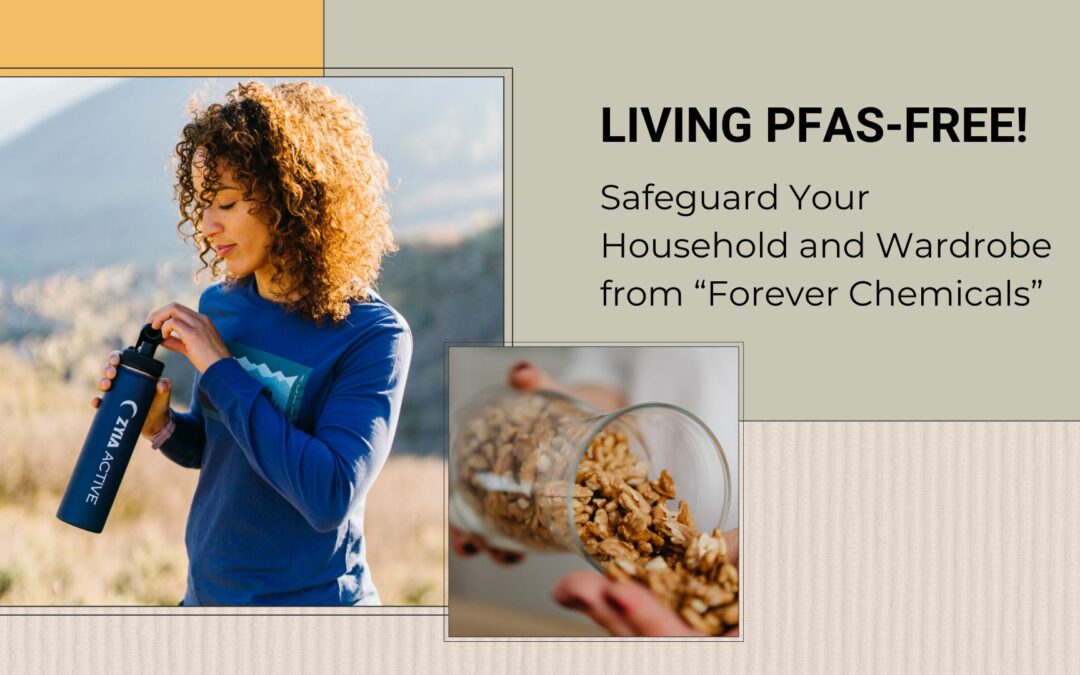Safeguard Your Household and Wardrobe from “Forever Chemicals”
Most of us are already trying to eat cleaner, use more organic products, and avoid harmful chemicals. But have you heard the term “forever chemicals” and wondered what it means? Or have you avoided finding out because you don’t have room for one more lifestyle change?
Take heart, brave consumer. In this article, we’ll break down the facts and give you simple steps to avoid these chemicals in your home, diet, and clothing.
What are PFAS, and why are they called “forever chemicals”?
“Forever chemicals” is a term commonly used to refer to the class of synthetic chemicals called per- and poly-fluoroalkyl substances (PFAS). The PFAS group includes various man-made compounds with strong carbon-fluorine bonds. These bonds make them highly resistant to degradation in the environment. That resistance to breaking down lets them stick around in water and soil, hence the nickname “forever chemicals.”
That’s as sciencey as we’re going to get, we promise. Now let’s connect that science to nostalgia. If you were born before 1990, you probably grew up in a home full of PFAS-treated items. Remember those stain-resistant carpets, the Scotch-Guarded sofas, Dad’s dry-cleaned suits, and those “miraculous” nonstick frying pans?
Fortunately, these types of wonder coatings have fallen out of favor in the last couple of decades. In 2002, 3M even changed the formulation in Mom’s trusty can of Scotch Guard to remove PFAS.
Why Should Health-conscious People Avoid PFAS?
The first reason to avoid PFAS is the health risk. Multiple studies have linked PFAS exposure in drinking water to adverse health effects such as increased cholesterol levels, liver damage, thyroid disruption, certain cancers, and immune system impairment. The other reason to be wary of PFAS is the environmental impact: their persistence in the environment can contaminate water sources, soil, and even wildlife.
Fortunately, PFAS use in consumer goods is dropping. Regulation and scrutiny have both increased, leading chemical makers to return to the drawing board on many of their formulations. But that doesn’t mean PFAS have gone away or that there’s one unifying standard of safety manufacturers must meet. Instead, consumers need to be mindful and educated to avoid PFAS chemicals.
Tips to Avoid PFAS in Your Household, Diet, and Clothing:
- Choose PFAS-Free Cookware:
- Opt for stainless steel, cast iron, or ceramic cookware instead of nonstick-coated pans, which often contain PFAS.
- Look for labels or certifications indicating that the cookware is free from PFAS, such as “PFOA-free” or “PFAS-free.”
- Be Mindful of Food Packaging:
- Avoid microwaving or heating food in containers labeled with recycling numbers 3, 6, or 7, as they may contain PFAS.
- Opt for glass, stainless steel, or silicone food storage containers to minimize contact with PFAS-containing packaging.
- Select PFAS-Free Personal Care Products:
- Read labels and avoid products containing “fluoro” or “perfluoro” ingredients, as they may indicate the presence of PFAS.
- Look for natural alternatives without synthetic fragrances, as they can also be a source of PFAS.
- Safeguard Your Drinking Water:
- Install a high-quality water filter certified to remove PFAS contaminants, such as activated carbon filters or reverse osmosis systems.
- Regularly replace filter cartridges as the manufacturer recommends to maintain optimal filtration efficiency.
- Make Mindful Textile Choices:
- Look for natural fibers like cotton, bamboo, hemp, or linen for bed linens and everyday wear. These are less likely to be treated with PFAS-based finishes.
- When buying performance clothing, look for brands that prioritize sustainability, quality, and that are transparent about their manufacturing standards.
- Wash clothing before wearing it, especially clothing that you wear to work out or directly against your skin.
- Cautious with Stain and Water Repellents:
- Be wary of terms like “water-resistant,” “stain-proof,” or “easy-clean,” as they may indicate the use of PFAS.
- Minimize your use of stain and water-repellent sprays that contain PFAS.
- Avoid dry-cleaning items that could be hand-washed.
Are Zyia Active Clothes PFAS-Free?
As a clothing manufacturer and champion of an active lifestyle, we at Zyia Active take personal health and the health of our planet seriously. We’ve worked hard to reduce our impact on the planet, including paperless shipping, recyclable or recycled packaging, recycled products, and a ban on the use of PFAS treatments in our factories. We actively review these expectations with each factory and hold them all to the same quality standard.
While independent analysis of a sample legging has already ranked our product favorably against competitors for the presence of PFAS, we’re looking forward to continuing to raise the bar in coming years.

